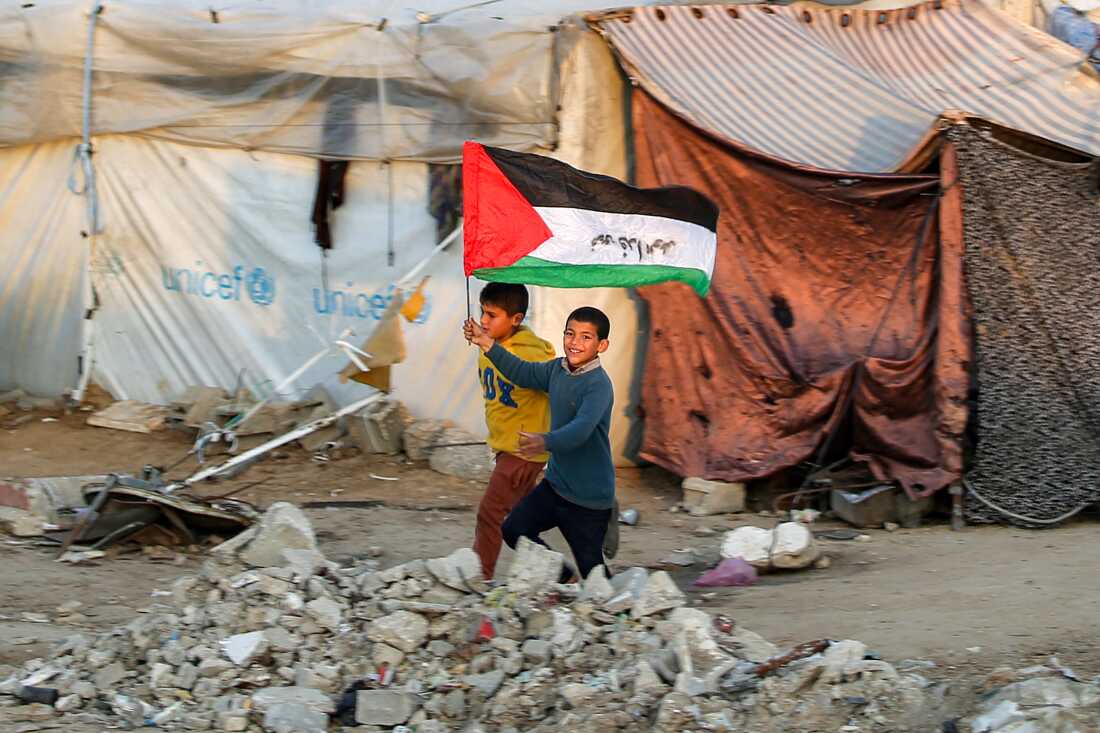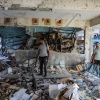
On Jan. 16, following a truce announcement amid the warfare between Israel and Hamas, a baby recovers books from the rubble of a constructing hit in Israeli strikes the earlier evening in Jabalia, within the northern Gaza Strip.
Omar Al-Qattaa/AFP
conceal caption
toggle caption
Omar Al-Qattaa/AFP
After greater than 15 months of relentless Israeli air and floor assaults on Gaza, most of the tiny Palestinian enclave’s 2 million residents are homeless and scrambling to acquire fundamental requirements. If final week’s ceasefire holds, specialists warning that rebuilding the devastated territory will take many years and price tens of billions of {dollars}.
The three-phase ceasefire deal locations the reconstruction of Gaza as the ultimate section, following a everlasting finish to the warfare. Dima Toukan, a nonresident scholar on the Center East Institute, says it is necessary to acknowledge that this final section could possibly be a good distance off — or by no means occur in any respect.
“The path forward beyond the first phase of the agreement is fraught with challenges and remains unclear,” she says.
The United Nations estimates that $50 billion might be required to rebuild Gaza, which occupies an space in regards to the measurement of Philadelphia on the Mediterranean coast between Israel and Egypt. Even the rosiest of estimates mission it could take a decade. However different predictions are rather more dire. A U.N. report issued in September estimates $18.5 billion price of injury was completed to Gaza’s infrastructure from the warfare’s begin by the tip of January 2024, and that when a ceasefire is reached, “a return to the 2007–2022 growth trend would imply that it would take Gaza 350 years just to restore GDP to its level in 2022.”
Listed here are 5 questions in regards to the huge reconstruction challenges confronted by Gaza.
What’s the scope of the destruction?
“At least a million people won’t have homes to return to,” says Shelly Culbertson, a senior researcher on the assume tank RAND. Most utilities, corresponding to electrical energy, sewage, water and communications aren’t working in Gaza, and the overwhelming majority of hospitals and colleges have been destroyed.
Somdeep Sen, an affiliate professor of worldwide improvement at Roskilde College in Denmark, says, “What we have witnessed is not just the material destruction of Gaza but also the destruction of the very fabric of Palestinian life in the enclave.”
In October, a yr after the warfare started, the U.N. mentioned Gaza’s human improvement index, a statistical measure that summarizes a rustic’s common human improvement, was anticipated to drop to a stage not seen since 1955, “erasing over 69 years of progress” there.

A girl walks previous the rubble of a collapsed constructing at a camp for individuals displaced by battle in Bureij, within the central Gaza Strip, on Jan. 17, following the announcement of a truce amid the warfare between Israel and Hamas.
Eyad Baba/AFP through Getty Pictures
conceal caption
toggle caption
Eyad Baba/AFP through Getty Pictures
Who pays?
The most important problem would be the most elementary one: The place will the cash come from? For apparent causes, Israel is an unlikely supply. In the meantime, neither Egypt nor Jordan has the assets or political will so as to add a lot, Sen says.
As an alternative, rich Gulf states corresponding to Qatar might must step in, he says. Even so, “without a large cohort of donors committed to the long-term recovery of Gaza, reaching [the $50 billion] mark will be difficult,” he says.
Even with out providing funding, Israel does have an necessary position to play, Sen says. “How Israel chooses to implement and interpret the ceasefire agreement and subsequently the nature/extent of its military control over the Gaza Strip will determine how much and how quickly the enclave can recover.”
As for funding, Culbertson, who has completed intensive work on the West Financial institution and Gaza, says the U.S. and European Union are additionally possible to supply funds.
One key problem is whether or not Israel continues its “dual use” import restrictions for Gaza on objects it deems could possibly be used both for legit civilian functions or to make weapons, Culbertson says. “The list … is fairly wide. It includes many materials necessary for reconstruction, like concrete, timber, rebar.”
What would be the greatest challenges?
Merely clearing particles might be a monumental process. Not solely are there large quantities of rubble to cope with, nevertheless it must be rigorously dealt with for things like unexploded ordnance, says Mark Jarzombek, an architectural historical past professor on the Massachusetts Institute of Expertise.
Jarzombek has studied how cities corresponding to Dresden, Germany — which was gutted by Allied bombing in 1945 — have been in a position to get better after World Battle II.
Battle-era buildings have been largely fabricated from brick and wooden, he says. “When those were bombed, they left big piles of that stuff,” Jarzombek explains. Consequently, postwar Dresden witnessed “brigades of women who would have wheelbarrows and go to the brick piles and then dump them in particular places.”
Not so in Gaza, the place buildings are made out of metal and concrete, he says. “In other words, you can’t get just local civilians [to] … take the stuff apart. You need special equipment: You need bulldozers. You need cranes,” Jarzombek says.
Toukan, of the Center East Institute, says the operation to take away rubble “will be a huge and costly endeavor” and might be sophisticated by occurring “in an area where the population cannot move freely.”
Water, sewage and electrical energy methods are all important. Gaza relied closely on desalination vegetation to produce water earlier than the warfare, however many have been destroyed. In the meantime, because the begin of the warfare, the electrical energy infrastructure has just about collapsed, in keeping with the United Nations. Restoring these companies might be troublesome.
Israeli bunker-busting bombs used to destroy Hamas tunnels may have destabilized the bottom below buildings, Jarzombek says. “Before you can even really do the housing, you need all the infrastructure that’s going to be necessary. … The pipes have to be laid.”
Given restricted assets, “rebuilding Gaza will entail prioritizing what to rebuild and when,” Sen says. Consequently, “the path to complete recovery will be drawn out.”

A boy, holding a Palestinian flag inscribed with the Arabic phrase “we sacrifice ourselves for the nation,” runs previous tents at a camp for individuals displaced by battle in Bureij on Jan. 17.
Eyad Baba/AFP through Getty Pictures
conceal caption
toggle caption
Eyad Baba/AFP through Getty Pictures
Who will handle the work?
Gaza will possible emerge from the battle and not using a functioning authorities. Even when Hamas stays intact, will probably be severely weakened after Israel’s relentless focusing on of its management, and the Islamist group’s grip on the territory will possible be tenuous at finest.
“This would need to be led (at least ostensibly) by a Palestinian partner,” Toukan says. The one viable accomplice is the a lot maligned Palestinian Authority, which she says has “a record of poor functionality and does not enjoy much legitimacy amongst Palestinians.”
Which means there will not be the form of central paperwork wanted to supervise rebuilding on such a large scale, Jarzombek says.
In Ukraine, he notes in contrast, you additionally see “very badly damaged cities and towns and villages.” However there’s nonetheless a working nation-state in Kyiv “that can monitor the funds and the flows and have some commitment to the legality of it all.”
That’s essential to facilitate numerous fundamental and important ground-level choices — the flexibility to say, “‘OK, that building has got to go … and for the next five years, we can house you here and then we can move you in there,'” in keeping with Jarzombek.
He wonders who will make these sorts of choices in Gaza. “It’s not clear,” Jarzombek says. “Who’s going to make them in a way that the Israelis are going to accept and that the Saudis or the Qataris or whoever is financing this stuff will accept?”
With out a stable authorities in place, there may also be considerations about corruption, says Culbertson. “Reconstruction funding is going to be all hands on deck,” she says, however drawing on the teachings that the U.S. discovered about corrupt contractors and officers throughout reconstruction in Iraq and Afghanistan, “it’s going to be hard to spend money with accountability.”
However setting apart these large obstacles, it is necessary that Gaza holds a stake in its personal reconstruction, says Sen, the Roskilde College professor.
“Palestinians in Gaza have gone through numerous cycles of destruction and rebuilding, not least since the start of the [Israeli] siege,” he says. “This manner of rebuilding following immense tragedy has been a hallmark of national struggle.”
When does momentary turn out to be everlasting?
Offering for individuals in Gaza might show all however unattainable, as Israel’s parliament has authorized severing all ties with UNRWA, the U.N. refugee company for Palestinians.

A tent camp for displaced Palestinians stands amid destroyed buildings within the Khan Younis refugee camp, within the southern Gaza Strip, on Jan. 4.
Abdel Kareem Hana/AP
conceal caption
toggle caption
Abdel Kareem Hana/AP
Toukan says dismantling UNRWA “would significantly impede the humanitarian response and recovery efforts, considering the organization’s unique positioning and capacity to provide services.”
The possible gradual tempo of reconstruction signifies that many Palestinians in Gaza might face a lifetime residing in refugee camps. This has occurred repeatedly throughout the globe, Culbertson says. Companies develop up across the camps, the place many individuals are compelled to make the very best of a foul scenario.
“It’s often a hugely flawed assumption that reconstruction will be fast.” It hardly ever is, she says.
Starting in 1948, a collection of refugee camps in Gaza have already turn out to be kind of everlasting communities, she says. “They built cinder block homes and other buildings where their tents had been, all in this initial footprint of a tent camp.”
Jarzombek highlights one more instance. “In Syria, they built these temporary camps for the refugees coming out of Iraq and other places that have been there now for 10 years or more,” he says. “They’ll be there for another decade, if not more. … We have this illusion that they’re temporary, but temporary things inevitably become permanent.”






